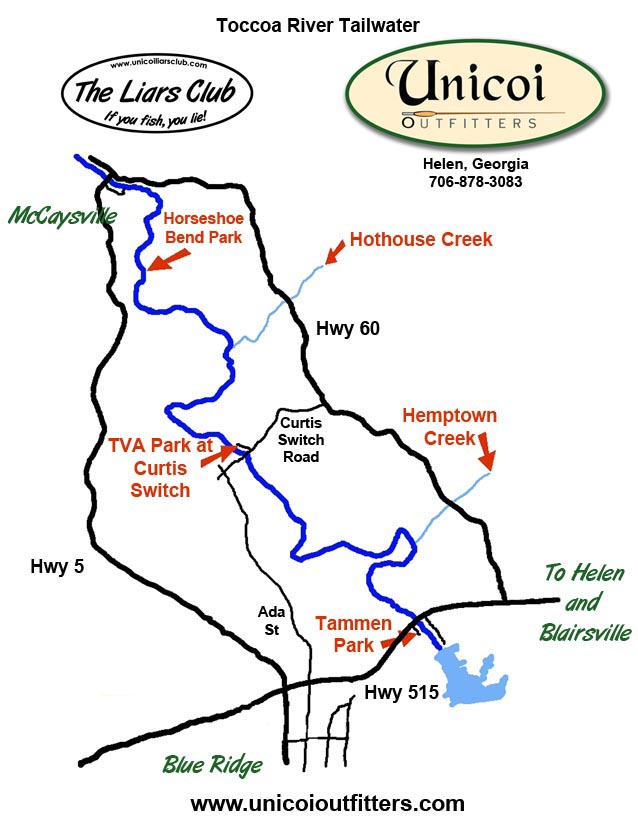Toccoa River
Tailwater Fishery Near Blue Ridge, Georgia
The south-to-north flowing Toccoa River is impounded by a TVA dam at Blue Ridge, Georgia, creating Blue Ridge Lake. The dam is a bottom-release dam, resulting in more stable temperatures throughout the year, and even better, cooler than average temperatures during the heat of the summer. In August 2006, when the Chattahoochee River in Helen hit 84 degrees, the Toccoa tailwater was sporting 53 degrees below the dam during release and it seldom rises above the mid 60s during the heat of the day, even when the TVA is not generating.
This adds up to excellent trout fishing. It also means there are other things to consider about your fishing trip to the Toccoa
that you might not need to thing about on your average Georgia mountain stream.
Safety
The first thing to keep in mind is safety. The TVA publishes a release schedule, but it is not guaranteed accurate. They may need to change their schedule due to electricity demands or other reasons. When the TVA is generating, the river is not wadable due to increased flows.
If you are wading, and the current comes up, it's time to exit the river - not after "one more cast", but now!
So, how do you know if the river is coming up? Well, first be familiar with the scheduled release times, and be aware of how long the
increased flows will take to reach you. See the chart to the left for times and distances from the dam for several key locations on the Toccoa.
But, as we said, the TVA doesn't always stick to the schedule, so be aware of your surroundings. The following usually mean that the river
is rising and it's time to get out:
If any of this happens, get out if wading, or get back in the boat if you're floating.
And always wear a wading belt - which is actually good advice everywhere you wade.
If you are thinking about floating, the minimum flow required for a good float is 125 cfs...this applies to rafts and drift boats.
The fishing is still good as low as 100 cfs, but the floating isn't.
For Release Information, Call TVA, 1-800-238-2264, then dial 4, 23, # to reach the Blue Ridge Dam Information or visit www.tva.com.
Access
The Toccoa tailwater has approximately 15.5 miles of fishable water. The majority of this is accessible only by floating. There are, however, three public access points that allow for wade fishing. These are also the spots available for put-in and take-out if you're floating.Tactics and Fly Selection
The Toccoa River tailwater is unlike any other stream in the mountains when it comes to fly selection. While most of the small freestone streams in this part of the world are deficient on bug life due to the natural pH of the water, the Toccoa River has great insect life and fairly predictable hatches. The generation of cold, clean water with good dissolved oxygen levels from Lake Blue Ridge is the cause of this anomaly. On the small mountain streams, while you may occasionally have to “match the hatch” to catch fish, most of the time you’ll find yourself fishing basic patterns that are either attractors or imitations of the year round buglife. In this case, presentation is everything. You make a good cast with a fly that resembles something the trout eats and you have a good chance of tempting a take. Elk hair caddis, parachute adams, humpies, stimulators, etc. are typical dry flies that can almost always find fish on these smaller streams. Most of the fish, however, will be caught below the surface by dropping a nymph of some fashion off the back of the dry fly or by weighting it heavily and dredging the bottom. This is Georgia mountain trout fishing.
On the Toccoa River tailwater, you’ll find a slightly different scenario. With the more ample supply of bugs, Toccoa trout
can be much more selective and, at times, downright unreasonable in their discernment. While you’ll never want to
leave your nymph or streamer box at home, there is an awful lot of very good dry fly fishing to be had here. In the dead
of winter, you’ll find caddis and stoneflies coming off. Late winter through spring look for great black caddis
hatches, Hendricksons, March Browns, and black or cream midges. In late spring and early summer, the sulfurs and
light cahills become dominant. Mid-summer will find grey caddis, small sulfurs and cream midges. Fall fishing is
tan caddis and midges.
Midges (in cream, grey or black) and blue winged olives are found coming off year round on the Toccoa so you should always
have these patterns in your box. Olive woolly buggers and leech patterns will also dredge up fish when nothing appears to
be happening on the surface. Our favorite method of fishing the Toccoa is with a 9 ft. 3 wt. or 4 wt. rod, 9 ft. 5X or 6X leader,
and a dry/dropper combination. An elk hair caddis with a small soft hackle pheasant tail or hares ear dropped about 20” off
the bend of the hook can be extremely productive.
When fish are rising, it is fairly easy to determine where the fish are. When they aren’t, a little more work is necessary but
can still be just as productive. There are sections of the Toccoa with a lot of ledges that hold fish in all the nooks and
crannies. Try swinging a soft hackle hares ear through these runs, either under a dry fly or a small indicator. The great thing
about soft hackle fishing is the inability to fish it wrong. While drag is critical with most dry flies and nymphs, it can
actually work to your advantage with the soft hackle fly. Cast quartering upstream as you would a dry and allow the fly to float
in the surface film as it moves downstream. If the soft hackle fly begins to sink slowly on its drift, continue fishing it as it
appears to be an insect trying to escape it’s shuck. On the tail end of your drift, simply allow the fly to swing around on a
tight line imitating an emerging insect rising to the surface. This action frequently results in the most hits as it appears
to be an escaping insect and the trout simply can’t resist the reflex reaction of chasing it.
It is more important on the Toccoa than any stream in Georgia to have the right flies but there are only a few patterns that you
must head out with to cover most situations. For up to date information on current conditions, call Unicoi Outfitters at 706-632-1880.
Toccoa River Tailwater Map

Click Here (or right-click to save) For Full-Sized Map
Toccoa River Tailwater
Time & Distance Info
| Location | Distance | Time |
|---|---|---|
| Hemptown Creek | 2.5 | 0:50 |
| Curtis Switch at TVA Park | 7.2 | 2:15 |
| Hothouse Creek | 9.8 | 3:15 |
| Horseshoe Bend | 13.2 | 4:25 |
| McCaysville Boat Ramp | 15.5 | 5:10 |
Distance is miles and time is hours and minutes. These are approximate. The measurements are relative to the dam. Note that these are not float times, but the time it takes for the river to start rising!
Example: The TVA starts generating at 12:00 noon. You will be able to fish until about 2:15pm at Curtis Switch TVA Park, or 4:25pm at Horseshoe Bend Park before the water starts rising.
Contact Unicoi Outfitters:
P.O. Box 419
7280 S. Main Street
Helen, Georgia 30545
(706) 878-3083
or by email.
Unicoi Outfitters is a permittee of the Chattahoochee-Oconee, Sumter, and Nantahala National Forests. See contact page for more information.


